Archive for the ‘Nail Fungus Cure’ Category
Removing All of or a Portion of Your Nail to Treat Nail Fungus – Is it Effective?
Removing All of or a Portion of Your Nail
to Treat Nail Fungus – Is it Effective?
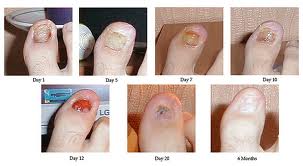 No one really knows. Little to no research has been done on removing all or part of the nail to treat a nail fungus infection. That’s because it’s sort of a last resort treatment for dealing with onychomycosis. However if you are unable to take any of the oral medications suggested for treating onychomycosis and if none of the topical solutions are effective, or if you have tried treating your nail fungus in several ways and none of them have been effective, then surgery may be an option.
No one really knows. Little to no research has been done on removing all or part of the nail to treat a nail fungus infection. That’s because it’s sort of a last resort treatment for dealing with onychomycosis. However if you are unable to take any of the oral medications suggested for treating onychomycosis and if none of the topical solutions are effective, or if you have tried treating your nail fungus in several ways and none of them have been effective, then surgery may be an option.
Another thing to consider is if you continue to experience recurring nail fungus infections, you might need to make some dietary changes and/or do a medical cleanse to get the possible sources of infection out of your system.
How does it work?
Your options for having your nail removed are as follows:
- Complete removal – known as avulsion
- Partial removal – known as debridement
There are also two options for having these procedures done:
- Surgery – Your doctor will numb the skin around and under your nail with a local anesthetic, either topical or a shot. Then a tool will be used to separate your nail from the surrounding skin and nail bed. (Your nail bed is the skin underneath your nail. This is most commonly where a nail fungus hides and breeds.) Once the nail has been removed your nail bed and surrounding skin should heal in 2-3 weeks.
- Ointment – Your doctor will cover the skin around your infected nail to protect it (similar to taping a window or door while painting.) Then an ointment will be put on the infected nail. The infected nail is covered with a plastic dressing, which will need to be kept dry. After a week to a week and a half, your nail should be soft enough to be removed by your doctor. The exposed nail bed and surrounding skin should heal in 2-3 weeks.
After you have undergone either of these procedures, your doctor will probably recommend taking an oral antifungal medication, or putting a topical ointment on the exposed nail bed to deliver the medicine directly to the affected area.
A fingernail, once the infected portion is removed should grow back healthy within about 6 months. A toenail may take up to 18 months to grow back.
If infection continues after this procedure, your doctor may recommend completely removing the nail again and putting a chemical on the cuticle (the soft layer of skin at the base of your nail) to prevent your nail from growing back.
Does it help?
Again, no one really knows as no one has put the time and research into the effects of removing part or all of the nail to cure onychomycosis.
So far, there is one reliable study that compared taking oral antifungal medication against other types of treatment, including removing part of the nail and putting a topical antifungal medication directly on the nail bed. The results were that people who chose the oral antifungal medication were happier with their treatment outcome than people who had part of their nail removed or who used any sort of topical remedy.
Possible Side Effects?
Once your nail has been removed from the nail bed, you will need to keep it clean and dry to prevent possible further infection of the area. Your doctor may also recommend using an antibiotic cream to ensure that everything heals well and stays healthy.
Another possible problem is that the side or corner of your nail could re-grow into the skin surrounding your toe. This is referred to as an ingrown toe nail. Mild symptoms of an ingrown toenail can be treated by soaking your foot in warm salt water and then propping the ingrown porting of your toenail to encourage it to grow above the skin. A more severe ingrown toenail will require you to return to your doctor for treatment.
What You Need To Know About Toenail Fungus
What You Need To Know About Toenail Fungus
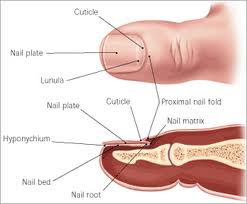 Toenail fungus infections are all caused by a fairly common set of conditions that can affect up to 12% of the American population. A fungus is a living organism that enjoys dark, damp places. Because of this, most people get a fungal nail infection in their toes. It does sometimes occur on fingernails, but as the feet offer a much more hospitable environment, that is the most sought after area for these little life-forms. The fungus can live along side the nail, or burrow underneath the nail. There are several factors that determine where the infection is actually located, two of which are the progression and severity of the infection.
Toenail fungus infections are all caused by a fairly common set of conditions that can affect up to 12% of the American population. A fungus is a living organism that enjoys dark, damp places. Because of this, most people get a fungal nail infection in their toes. It does sometimes occur on fingernails, but as the feet offer a much more hospitable environment, that is the most sought after area for these little life-forms. The fungus can live along side the nail, or burrow underneath the nail. There are several factors that determine where the infection is actually located, two of which are the progression and severity of the infection.
Doctors have noticed that a the beginning of an occurrence, it is most likely that the fungus lives along side the nail and gradually works its way underneath the nail to the nail bed as the infection progresses. Early symptoms of a fungal nail infection include a white or yellowish spot on the nail. As pain or discomfort are not common at this stage of infection, most people don’t notice the problem until it has progressed further.
As the infection develops, things become a bit more noticeable, even if these changes happen slowly. The nail dulls and gradually becomes yellowed and sometimes the toenail changes its shape. This is caused by the thickening of the nail and potential crumbling at the edges as it becomes more brittle and frail. The thick, yellowing, ridged nail is the trademark of the condition. This is when people tend to feel discomfort from the infection, sometimes caused by the nail separating from the nail bed.
If you allow this condition to progress sufficiently that your toenail separates from the nail bed, exposing the soft skin below, it is possible that this can result in further, and more serious, infection. If you see pus oozing from your toe, or if there is a bad odor when you take off your sock, it is now time to go see your doctor, immediately.
The myth about the toenail fungus microorganism is that it is only found in dirty places. Much like its cousin, the mushroom, this microorganism is happy to breed wherever and whenever it can. If its living conditions are correct, it will be there and will inevitably come into contact with hands and feet that it will send its spores onto to continue increasing the population. This is a fungus that everyone comes into contact with daily. Infection occurs when you give the fungus an environment in which it can thrive.
The medical community refers to this particular fungus as dermatophytes. While there are other causes of nail fungus infection, including yeast and mold, dermatophytes are the most common culprit.
There are things that may make a person more susceptible to toenail fungus, such as:
- An unhealthy immune system
- Peripheral artery disease
- Trauma to the foot, especially if the toenail has been damaged
- Abnormal skin pH
- Poor hygiene
- Previous fungal nail infections
It is unlikely that a fungal nail infection will become life threatening or debilitating. However they can cause pain and discomfort as well as affect a person’s self esteem because of the appearance of the nail. Because treating toenail fungus can be difficult, doing your best to prevent infection is the most effective cure. If you are concerned that you have an infected toenail, consult with your health care provider. Between the two of you, the state of your foot health can be determined and a course of action can be enacted.
How Can I Permanently Cure My Toenail Fungus?
How Can I Permanently Cure My Toenail Fungus?
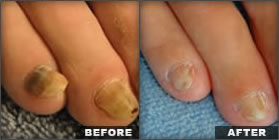 Doctors tend to shy away from the word “cure” when referring to toenail fungus because it is not an easy thing to do. We have become a very busy society that believes popping a pill will take care of everything. Unfortunately that is not the case with toenail fungus. Onychomycosis, the medical term for toenail fungus is hard to cure because the treatment regimen is very long and can be quite involved. Most kinds of fungus are able to lie dormant for a long period so people will go through treatment and get positive results, only to find that the infection returns. Curing toenail fungus permanently is a possibility, it just take work and patience.
Doctors tend to shy away from the word “cure” when referring to toenail fungus because it is not an easy thing to do. We have become a very busy society that believes popping a pill will take care of everything. Unfortunately that is not the case with toenail fungus. Onychomycosis, the medical term for toenail fungus is hard to cure because the treatment regimen is very long and can be quite involved. Most kinds of fungus are able to lie dormant for a long period so people will go through treatment and get positive results, only to find that the infection returns. Curing toenail fungus permanently is a possibility, it just take work and patience.
Several factors must be taken into account when examining your chances of curing toenail fungus. First is how far along your toenail fungal infection is. If you can catch it early, you stand a better chance of eliminating it entirely. As a fungal infection progresses, it goes from the skin surrounding the toenail into and under the toenail, where it becomes much harder to eradicate. Second is your own level of commitment. Treating toenail fungus is much more involved than just taking a pill. The idea is to create a hostile environment for the fungus so that they die off. This may involve washing your feet several times a day with a special soap and then donning clean socks each time. Yes, this is a lot of work (and extra laundry) but if you wish to control and end the toenail fungal infection, you will need to follow all of your doctor’s instructions as well as educate yourself on how to avoid recurrence.
The most unfortunate part about curing toenail fungus is that the statistics are so out of whack on actual success because so many people get frustrated part way through their cure and give up, or they miss a day or two and get pushed back by two weeks. This negates the outcome of the studies that have been done, or at least makes the conclusion “unknown”. If you are going to treat your toenail fungus, you need to address all of the problems and be willing to put in the time and effort it will take to achieve a successful result.
Oral prescription medication
If you and your doctor decide that the oral prescription medication is the way to go, ask about helping the process along by using a natural topical antifungal like Tea Tree Oil as part of your healing regimen. Giving your body help from both the inside and the outside can work in your favor. The goal behind combining your efforts is to permanently eradicate the fungi living off of you. This combination of efforts will take effort on your part in maintaining a healthy for you/not healthy for the fungus environment.
The biggest barrier to a cure for toenail fungus for most people is the amount of time and work that go into treatment of this disease. Washing your feet and applying medication 2-3 times a day as well as doing extra laundry to make sure your socks are clean and finding shoes that allow your feet to breath will become stressful. You must remember that missing one day of treatment will undo the last four you worked so hard on as it only takes the fungus one day to re-establish themselves. If you can stick to the program, with the help of your doctor, you can permanently end your toenail fungus problem.
Curing Toenail Fungus with Tea Tree Oil
Curing Toenail Fungus with Tea Tree Oil
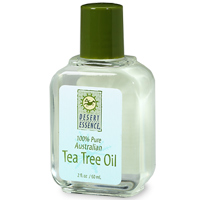 It is very uncommon for a doctor to recommend an alternative remedy over a prescription medicine. However in the case of Tea Tree Oil, this happens more often than not. Tea Tree Oil is a naturally occurring medicine and has been shown to be effective at eliminating the fungus that causes toenail infections. The Mayo Clinic has even run studies to confirm this. So why is this oil so effective? Because of its own natural physical properties.
It is very uncommon for a doctor to recommend an alternative remedy over a prescription medicine. However in the case of Tea Tree Oil, this happens more often than not. Tea Tree Oil is a naturally occurring medicine and has been shown to be effective at eliminating the fungus that causes toenail infections. The Mayo Clinic has even run studies to confirm this. So why is this oil so effective? Because of its own natural physical properties.
This plant is native to Australia and has been used for centuries by the aboriginal people for curing and preventing infections. The plant acts as an antimicrobial and while the medical community sees much potential in the Tea Tree, the majority of studies have centered around Tea Tree Oil being used as an antifungal. The treatment of a fungal infection takes a long time and it is not uncommon for someone participating in a study to give up and drop out part way through. Even one person doing this can throw off the results of a study, leaving it with the result of “null and void” or “unclear”.
Tea Tree Oil Popularity
No matter that the Mayo Clinic has run studies on this product, the general public has taken to Tea Tree Oil like a duck to water. If you run a search on Tea Tree Oil, you will find not only a wide variety of products and distributors, but also people singing its praises, telling how it helped them treat their toenail fungus infections. This information can be found both as testimonials on distributor websites but also as entries and responses on forums. This is real data submitted by real people, saying how happy they are that they were able to find a natural remedy to cure their nail fungus infection completely and inexpensively. As with all medications, both prescription and alternative, the results will vary from person to person and how long it takes or if it is effective will depend on the severity of the infection.
It is recommended that the strength of the Tea Tree Oil is 100% and that it is applied to the surface of the infected nail and surrounding tissue to ensure that all hiding places for the fungus are covered. If you plan on a Tea Tree Oil regimen, it is recommended to purchase some soap or shampoo that contains Tea Tree Oil and use it to wash your feet several times a day. Once your feet are clean, dry them thoroughly and then apply the Tea Tree Oil directly to the affected areas. Mind the amount you use as too much can cause irritation.
Please note: Tea Tree Oil is a topical treatment only and should never be ingested as it can cause a severe toxic reaction! As with any medication, if you experience an allergic reaction, discontinue use immediately, wash the affected areas with soap that doesn’t contain tea tree oil and contact your doctor. This may be an herbal remedy, but your doctor should still be informed that you are using it and how you are progressing because it is still a medication, even if it is a natural one. This is even more important if you have any sort of skin condition, such as eczema. Remember that fungus like dark, damp environments and the more you can do to discourage a place for them to develop, the less likely it will be that you will contract an infection.
Paronychia
Paronychia
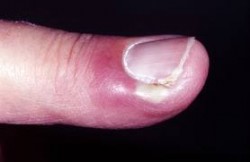 aronychia is a disease of the Perineum, where the skin around the surface of the nail hangs loosely. It has been found most often in the U.S., usually in kids who have a habit of biting their nails or sucking their fingers. There two forms of Paronchial infection, Chronic Paronychia and Acute Paronychia. The forms are judged according to the length of time it remains in the body.
aronychia is a disease of the Perineum, where the skin around the surface of the nail hangs loosely. It has been found most often in the U.S., usually in kids who have a habit of biting their nails or sucking their fingers. There two forms of Paronchial infection, Chronic Paronychia and Acute Paronychia. The forms are judged according to the length of time it remains in the body.
Paronychia is a viral infection that grows gradually stronger, resulting in a bumpiness, softness and redness surrounding the nails. The main culprits for this infection are Candida and mold. It can be passed from person to person via touch.
Causes of Paronychia
Most forms of Paronychia occur by a nick or break in the skin being infected. If a person has a hangnail or a habit of chewing their nails, this is a good way for the infection to enter the area. There is evidence of Streptococcus and Pseudomonas germs getting into the infected area and making it worse. The chronic form of Paronychia is typically linked with the use of abrasives, for instance soaps and detergents while washing. The chronic infections are typically the result of Candida albcans or other fungus.
Acute Paronychia occurs when the skin around the nail becomes inflamed and swells causing pain to the afflicted person. Pus may develop and ooze from the infected area, removing the top layer of the nail.
Chronic Paronychia is a longer lasting case and the nails can become so infected that they develop a greenish tinge around the edges of the skin.
Diagnosis
In the cases of Acute Paronychia, a culture of the pus can be taken to determine what kind (or kinds) of infection is occurring and then treatment can be prescribed. Chronic Paronychia can be a bit more difficult to diagnose and treat, though a potassium hydroxide test may be able to determine which fungus is the source of the infection.
Treatment
- Massaging the afflicted area in hot water three to four times per day can help relieve some of the pain and swelling
- Antibiotics such as diclogacilin and cephelaxin may be prescribed
- If the swelling is severe, the area may need to be punctured and drained
- Part of the nail may need to be removed in some cases
- An antifungal may also be prescribed
Things that should NOT be used to cure Paronychia
- Do not use topical antibiotics
- Do not take prescribed steroids
Unusual cases of people who have contracted Paronychia have occurred in patients with:
- HIV/AIDS
- On steroids
- High blood sugar
- Poor circulation
Prevention
- Don’t chew or bite your nails
- Don’t suck on your fingers or thumbs
- Don’t immerse your hands in water without wearing protective gloves